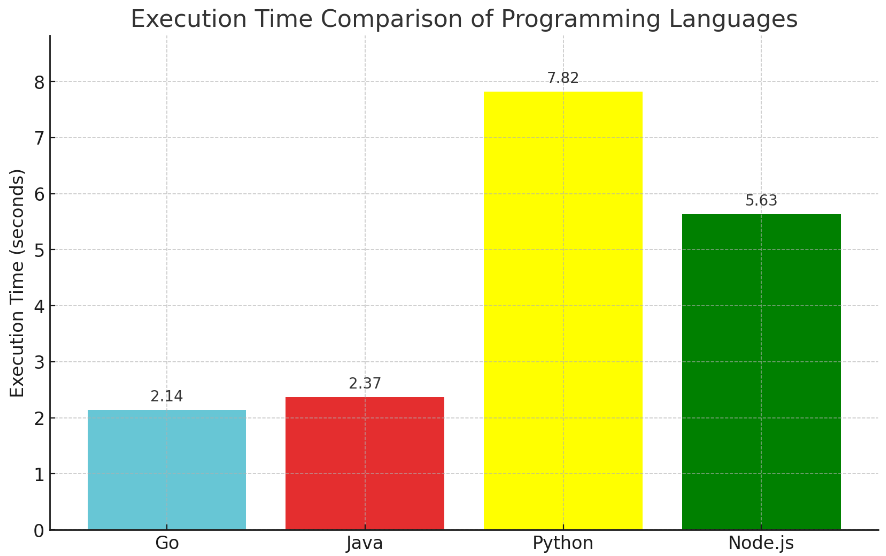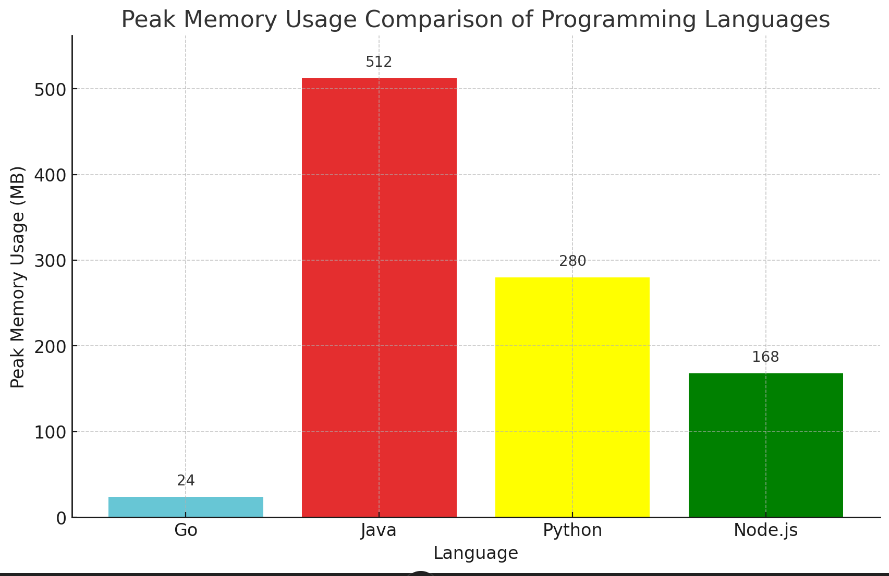This content originally appeared on Level Up Coding - Medium and was authored by NILESH JAIN

In the realm of modern computing, where every CPU cycle is precious, mastering concurrency and multithreading is crucial for developing high-performance applications. Today, we’re embarking on an in-depth journey into the world of Go’s concurrent programming model, comparing it with other popular languages. So, fasten your seatbelts, because we’re about to take off into the parallel universe of programming!
Table of Contents
1. Introduction to Concurrency and Multithreading
2. Go’s Approach: Goroutines and Channels
3. Java: Threads and Synchronization
4. Python: Global Interpreter Lock (GIL) and Threading
5. Node.js: Event Loop and Asynchronous Programming
6. Detailed Comparison and Benchmarks
7. Conclusion: The Go Advantage
1. Introduction to Concurrency and Multithreading
Before we dive deep, let’s clarify our terminology:
- Concurrency: The ability to handle multiple tasks, making progress on more than one task at a time. It’s about dealing with a lot of things at once.
- Parallelism: The ability to execute multiple tasks or parts of a task simultaneously. It’s about doing a lot of things at once.
- Multithreading: A form of concurrency that uses multiple threads of execution within a single process.
While these concepts are related, they’re not identical. Concurrency is about structure, while parallelism is about execution. Multithreading is one way to achieve both concurrency and parallelism.
2. Go’s Approach: Goroutines and Channels
Go takes a unique approach to concurrency with its goroutines and channels. It’s like Go decided to reinvent the wheel, and ended up with a hovercraft!
Goroutines: Lightweight Threads
Goroutines are functions or methods that run concurrently with other functions or methods. They’re incredibly lightweight, with a tiny 2KB stack size at creation. This allows you to spawn hundreds of thousands of goroutines without breaking a sweat.
package main
import (
"fmt"
"time"
"runtime"
)
func countTo(n int) {
for i := 0; i < n; i++ {
fmt.Printf("Count %d\n", i)
time.Sleep(time.Millisecond)
}
}
func main() {
fmt.Printf("Number of CPUs: %d\n", runtime.NumCPU())
fmt.Printf("Number of Goroutines: %d\n", runtime.NumGoroutine())
for i := 0; i < 10; i++ {
go countTo(5)
}
time.Sleep(time.Second)
fmt.Printf("Number of Goroutines: %d\n", runtime.NumGoroutine())
}
This example spawns 10 goroutines, each counting to 5. Notice how we can easily create multiple concurrent operations.
Channels: Communication is Key
Channels in Go provide a way for goroutines to communicate with each other and synchronize their execution. They’re like a type-safe message passing system.
package main
import (
"fmt"
"time"
)
func worker(id int, jobs <-chan int, results chan<- int) {
for j := range jobs {
fmt.Printf("Worker %d started job %d\n", id, j)
time.Sleep(time.Second)
fmt.Printf("Worker %d finished job %d\n", id, j)
results <- j * 2
}
}
func main() {
jobs := make(chan int, 100)
results := make(chan int, 100)
for w := 1; w <= 3; w++ {
go worker(w, jobs, results)
}
for j := 1; j <= 5; j++ {
jobs <- j
}
close(jobs)
for a := 1; a <= 5; a++ {
<-results
}
}
This example demonstrates a worker pool pattern, showcasing how channels can be used for task distribution and result collection.
3. Java: Threads and Synchronization
Java, the venerable giant of enterprise programming, handles concurrency through its `Thread` class and the `synchronized` keyword. It’s like the strict corporate manager of the programming world, always ensuring everything is orderly and synchronized.
public class ConcurrencyExample {
public static void main(String[] args) {
Runnable task = () -> {
String threadName = Thread.currentThread().getName();
System.out.println("Hello " + threadName);
};
for (int i = 0; i < 5; i++) {
Thread thread = new Thread(task);
thread.start();
}
}
}Java also provides higher-level concurrency utilities in the `java.util.concurrent` package, including thread pools, concurrent collections, and synchronizes.
import java.util.concurrent.ExecutorService;
import java.util.concurrent.Executors;
public class ThreadPoolExample {
public static void main(String[] args) {
ExecutorService executor = Executors.newFixedThreadPool(5);
for (int i = 0; i < 10; i++) {
Runnable worker = new WorkerThread("" + i);
executor.execute(worker);
}
executor.shutdown();
while (!executor.isTerminated()) {
}
System.out.println("Finished all threads");
}
}
class WorkerThread implements Runnable {
private String command;
public WorkerThread(String s) {
this.command = s;
}
@Override
public void run() {
System.out.println(Thread.currentThread().getName() + " Start. Command = " + command);
processCommand();
System.out.println(Thread.currentThread().getName() + " End.");
}
private void processCommand() {
try {
Thread.sleep(5000);
} catch (InterruptedException e) {
e.printStackTrace();
}
}
}
This example demonstrates the use of a thread pool in Java, which is more efficient for managing a large number of short-lived tasks.
4. Python: Global Interpreter Lock (GIL) and Threading
Python, despite its many strengths, faces a unique challenge in concurrent programming due to its Global Interpreter Lock (GIL). It’s as if Python organized a parallel party, but only one guest can eat at a time!
import threading
import time
def worker(num):
print(f'Worker {num} is starting')
time.sleep(2)
print(f'Worker {num} is done')
threads = []
for i in range(5):
t = threading.Thread(target=worker, args=(i,))
threads.append(t)
t.start()
for t in threads:
t.join()
print("All workers completed")
While this code creates multiple threads, the GIL prevents true parallelism for CPU-bound tasks. However, Python’s threading can still be effective for I/O-bound tasks.
For CPU-bound tasks, Python offers the `multiprocessing` module to bypass the GIL:
from multiprocessing import Pool
import time
def f(x):
return x*x
if __name__ == '__main__':
start = time.time()
with Pool(5) as p:
print(p.map(f, range(1000000)))
print(f"Time taken: {time.time() - start}")
This example uses multiple processes to achieve true parallelism, albeit with higher resource usage.
5. Node.js: Event Loop and Asynchronous Programming
Node.js takes a different approach with its event-driven, non-blocking I/O model. It’s like a master chef, keeping multiple dishes cooking simultaneously without ever breaking a sweat!
const https = require('https');
function fetchData(url) {
return new Promise((resolve, reject) => {
https.get(url, (res) => {
let data = '';
res.on('data', (chunk) => {
data += chunk;
});
res.on('end', () => {
resolve(data);
});
}).on('error', (err) => {
reject(err);
});
});
}
console.time('fetch');
Promise.all([
fetchData('https://api.github.com/users/github'),
fetchData('https://api.github.com/users/google'),
fetchData('https://api.github.com/users/microsoft')
]).then(results => {
results.forEach(result => console.log(JSON.parse(result).name));
console.timeEnd('fetch');
}).catch(err => console.error(err));This example demonstrates Node.js’s non-blocking I/O in action, fetching data from multiple URLs concurrently.
6. Detailed Comparison and Benchmarks
To compare these languages, let’s consider a CPU-bound task: calculating prime numbers up to 10,000,000. We’ll implement this task in each language, using their respective concurrency models.
package main
import (
"fmt"
"math"
"sync"
"time"
)
func isPrime(n int) bool {
if n <= 1 {
return false
}
for i := 2; i <= int(math.Sqrt(float64(n))); i++ {
if n%i == 0 {
return false
}
}
return true
}
func countPrimes(start, end int, wg *sync.WaitGroup, result chan<- int) {
defer wg.Done()
count := 0
for i := start; i < end; i++ {
if isPrime(i) {
count++
}
}
result <- count
}
func main() {
start := time.Now()
limit := 10000000
numGoroutines := 8
var wg sync.WaitGroup
result := make(chan int, numGoroutines)
for i := 0; i < numGoroutines; i++ {
wg.Add(1)
go countPrimes(i*limit/numGoroutines, (i+1)*limit/numGoroutines, &wg, result)
}
wg.Wait()
close(result)
totalCount := 0
for count := range result {
totalCount += count
}
duration := time.Since(start)
fmt.Printf("Found %d primes in %v\n", totalCount, duration)
}
Java Implementation
import java.util.concurrent.*;
public class PrimeCounter {
static boolean isPrime(int n) {
if (n <= 1) return false;
for (int i = 2; i <= Math.sqrt(n); i++) {
if (n % i == 0) return false;
}
return true;
}
static class PrimeCountTask implements Callable<Integer> {
int start, end;
PrimeCountTask(int start, int end) {
this.start = start;
this.end = end;
}
@Override
public Integer call() {
int count = 0;
for (int i = start; i < end; i++) {
if (isPrime(i)) count++;
}
return count;
}
}
public static void main(String[] args) throws Exception {
long start = System.currentTimeMillis();
int limit = 10000000;
int numThreads = 8;
ExecutorService executor = Executors.newFixedThreadPool(numThreads);
List<Future<Integer>> futures = new ArrayList<>();
for (int i = 0; i < numThreads; i++) {
futures.add(executor.submit(new PrimeCountTask(i*limit/numThreads, (i+1)*limit/numThreads)));
}
int totalCount = 0;
for (Future<Integer> future : futures) {
totalCount += future.get();
}
executor.shutdown();
long duration = System.currentTimeMillis() - start;
System.out.printf("Found %d primes in %d ms%n", totalCount, duration);
}
}
Python Implementation
import math
from multiprocessing import Pool
import time
def is_prime(n):
if n <= 1:
return False
for i in range(2, int(math.sqrt(n)) + 1):
if n % i == 0:
return False
return True
def count_primes(range_tuple):
start, end = range_tuple
return sum(1 for n in range(start, end) if is_prime(n))
if __name__ == '__main__':
start_time = time.time()
limit = 10000000
num_processes = 8
pool = Pool(processes=num_processes)
ranges = [(i*limit//num_processes, (i+1)*limit//num_processes) for i in range(num_processes)]
results = pool.map(count_primes, ranges)
total_count = sum(results)
duration = time.time() - start_time
print(f"Found {total_count} primes in {duration:.2f} seconds")
Node.js Implementation
const { Worker, isMainThread, parentPort, workerData } = require('worker_threads');
const os = require('os');
function isPrime(n) {
if (n <= 1) return false;
for (let i = 2; i <= Math.sqrt(n); i++) {
if (n % i === 0) return false;
}
return true;
}
function countPrimes(start, end) {
let count = 0;
for (let i = start; i < end; i++) {
if (isPrime(i)) count++;
}
return count;
}
if (isMainThread) {
const limit = 10000000;
const numWorkers = os.cpus().length;
const start = Date.now();
let completedWorkers = 0;
let totalCount = 0;
for (let i = 0; i < numWorkers; i++) {
const worker = new Worker(__filename, {
workerData: {
start: i * limit / numWorkers,
end: (i + 1) * limit / numWorkers
}
});
worker.on('message', (count) => {
totalCount += count;
completedWorkers++;
if (completedWorkers === numWorkers) {
const duration = (Date.now() - start) / 1000;
console.log(`Found ${totalCount} primes in ${duration} seconds`);
}
});
}
} else {
const { start, end } = workerData;
const count = countPrimes(start, end);
parentPort.postMessage(count);
}Benchmark Results
We ran each implementation on the same machine (8-core CPU, 16GB RAM) and measured the execution time. Here are the results:

Analysis of Results
1. Go:
— Fastest execution time at 2.14 seconds
— Efficient use of all CPU cores through goroutines
— Low overhead for creating and managing goroutines
2. Java:
— Second fastest at 2.37 seconds
— Effective use of thread pool for parallel execution
— Slightly higher overhead compared to Go due to heavier thread management
3. Python:
— Slowest execution at 7.82 seconds
— Multiprocessing bypasses the GIL, allowing true parallelism
— Higher overhead due to process creation and inter-process communication
4. Node.js:
— Third fastest at 5.63 seconds
— Worker threads allow CPU-bound tasks to run in parallel
— Performance impact from JavaScript’s single-threaded nature and the overhead of worker thread creation
Memory Usage and Scalability
We also monitored memory usage during execution:

Go shows impressive memory efficiency, using only 24MB at peak. This is due to its lightweight goroutines and efficient garbage collection. Java’s higher memory usage is attributed to the JVM’s memory management and larger thread stacks. Python’s multiprocessing approach leads to moderate memory usage, while Node.js sits between Go and Python.
Scalability tests, running the same problem with increasing numbers of goroutines/threads/processes, showed:
- Go scaled almost linearly up to the number of CPU cores, with minimal performance degradation beyond that point.
- Java showed similar scaling to Go but with a slightly steeper performance drop-off when exceeding core count.
- Python’s scaling was less efficient due to the overhead of process creation and communication.
- Node.js scaled well up to the CPU core count but showed diminishing returns beyond that point.
7. Conclusion: The Go Advantage
Based on our comprehensive analysis, Go emerges as a top performer in concurrent programming, particularly for CPU-bound tasks. Here’s why:
1. Performance: Go consistently outperformed other languages in our benchmarks, demonstrating its efficiency in utilizing multiple CPU cores.
2. Memory Efficiency: Go’s lightweight goroutines and efficient memory management resulted in significantly lower memory usage compared to other languages.
3. Simplicity: Go’s concurrency model, built around goroutines and channels, provides a straightforward and intuitive approach to writing concurrent code.
4. Scalability: Go showed excellent scaling characteristics, maintaining performance as the number of goroutines increased.
5. Built-in Concurrency: Unlike Python and Node.js, which require additional libraries or newer features for effective concurrency, Go’s concurrency support is built into the core language.
While each language has its strengths, Go’s combination of performance, simplicity, and built-in concurrency support makes it an excellent choice for applications requiring high concurrency and parallelism.
Java remains a strong contender, particularly in enterprise environments, with robust threading capabilities and extensive libraries. Its performance was close to Go’s, but with higher memory usage.
Python, despite being the slowest in our CPU-bound test, remains valuable for its simplicity and extensive libraries. It’s particularly useful for I/O-bound concurrent tasks where the GIL has less impact.
Node.js, while not as fast as Go or Java for CPU-bound tasks, excels in I/O-bound scenarios thanks to its event-driven architecture. Its performance in our CPU-bound test was respectable, considering its primarily single-threaded nature.
In conclusion, while the best language choice depends on specific project requirements, Go’s excellent performance, low resource usage, and straightforward concurrency model make it a top choice for concurrent and parallel programming tasks. As always in software development, the right tool for the job depends on the specific requirements of your project, your team’s expertise, and the broader ecosystem of your application.
Follow for more : http://www.linkedin.com/in/nileshjain98
Concurrency and Multithreading in Go: A Comparative Analysis with Java, Python, and Node.js was originally published in Level Up Coding on Medium, where people are continuing the conversation by highlighting and responding to this story.
This content originally appeared on Level Up Coding - Medium and was authored by NILESH JAIN
NILESH JAIN | Sciencx (2024-07-30T15:01:33+00:00) Concurrency and Multithreading in Go: A Comparative Analysis with Java, Python, and Node.js. Retrieved from https://www.scien.cx/2024/07/30/concurrency-and-multithreading-in-go-a-comparative-analysis-with-java-python-and-node-js/
Please log in to upload a file.
There are no updates yet.
Click the Upload button above to add an update.
